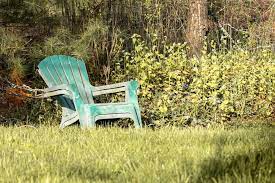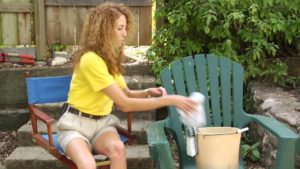Last updated on January 20th, 2022
When it comes to creating a perfectly sparkling outdoor space to unwind during summer or spring, you will need outdoor chairs, and plastic chairs are an ideal fit. Unfortunately, plastic eventually gets oxidized just like metals, and when this happens, it can be dull and disgusting to look upon. A frequently asked question by most homeowners is how to clean oxidized plastic patio chairs.There are three main ways to restore your oxidized plastic patio chairs, all of which involve the use of home-ready products. Some of these include vinegar, baking soda, bleach, and a heat gun.
Although implementing these methods might take some time, you will be blown by the result. Think about how much you would spend if you decided to replace the chairs or hire a cleaning company. By learning how to remove oxidation from plastic when it appears, you can save your money.
Below, we discuss the methods and offer tips on how to prevent or remove oxidation from plastic patio furniture.
Table of Contents
What is Oxidation?
Oxidation is a process that involves the addition of oxygen to a chemical substance causing it to lose some of its electrons. Some compounds and elements oxidize more readily than others.
Some good examples are metals such as iron and magnesium. The oxidation of iron results in the formation of iron oxide, which is what you know as “rust,” while the oxidation of magnesium forms magnesium oxide.
It is important to note that oxidation can be either spontaneous, such as the rusting of iron. Or it can be artificially initiated, such as the preparation of sodium oxide in the laboratory. Sometimes it can be helpful, and at other times it could be destructive.
For example, consider how bleach is used to remove stains in cloth. Here, the bleach oxidizes the compounds responsible for the stains on the cloth and restores the cloth to a clean state.
In the same manner, many of the food we eat is loaded with antioxidants that help counter the harmful effects of oxidation inside our body. Have you ever wondered why some fruits turn brownish after they are cut and left in the air for some time? Well, that’s oxidation taking place.
On the bad side, oxidation is responsible for the brittle, reddish powder you see on iron after it has been exposed to air (oxygen) and moisture for a long time. This is commonly regarded as “rust.” Oxidation is also responsible for the fade or dullness in the appearance of plastic after it’s been exposed to air and sunlight for a long time.
Although oxidation is slower in plastics compared to metals, the results can be undesirable. The best form of defense is to keep your plastic furniture away from direct sunlight or at least minimize it.
Why Plastic chairs oxidize?
Plastic chairs oxidize after being exposed to air and sunlight for a long time. These elements trigger the emission of certain chemicals, which in turn react with the oxygen in the air, and UV radiation from the sun. The result is photo-oxidation.
Besides plastic, this type of oxidation can occur in almost any material exposed to the sun for extended periods, although the resultant effect may not be the same. Some of these materials include car paint, iron, fiberglass, and aluminum.
What is the effect of oxidation on plastic patio chairs?
The oxidation of plastic commonly leads to degradation, which causes the upper layer to dry out, thus making the plastic look dull and lackluster. If you do not clean oxidation off plastic on time, the plastic patio chair will eventually become brittle and might crack.

Some plastic chairs commonly feature additives that help to reduce or slow down oxidation. However, this is often not the case with older plastic chairs which usually have a higher risk of degrading.
Besides affecting the look of your plastic furniture, oxidation can also lead to the release of residue dust and VOCs (volatile organic compounds) in the surrounding atmosphere. This can cause eye irritation, amongst other health risks.
As earlier indicated, removing oxidation gives you the best chance of restoring your plastic lawn chairs. And that is what I will be showing you how to do in the next section.
How do you remove oxidation from plastic patio chairs?
An oxidized plastic chair can quickly take on an unsightly appearance. Follow the steps below to remove oxidation from plastic patio chairs.
Clean the Chairs
Before applying any one of the methods below, you need to get rid of dirt, slime, and debris on the chairs. For this, you will need a sponge and soapy water. Avoid using hard brushes or scourers on plastic surfaces, or you might end up scratching them. If you don’t want to use a cloth, then a sponge will do.
Once you’re done cleaning the chairs with the sponge and water, rinse thoroughly with water.
Get Rid of Mold
Once you are done with the initial washing of the chairs, the next thing is to remove the molds. There’s no way you can effectively restore a piece of plastic furniture without dealing with mold buildup.
For this, you will need a solution of water and vinegar. Mix ¼ cup of white vinegar to warm water in a spray bottle. Or, if you know how to clean chairs with baking soda, you can follow the procedure. After making a solution, spray the mixture on the affected areas of your plastic. You can use a soft cloth or brush to rub it gently. Let it sit for about 30 minutes, then rinse carefully with a hose.
You can repeat the step if you feel they’re still molds hanging in there.
How to clean oxidized plastic patio chairs
We are now ready to revive plastic garden furniture surfaces. There are three main ways to go about it using ready-made home products.
Method 1: Using Baking Soda
After you’re done with the initial cleaning, you can go ahead and apply baking soda to remove oxidation. Depending on how much your chair is affected, you will likely need a good amount of baking soda.
- Dip a sponge into a bowl of warm water, then remove it and spread baking soda on it.
- Next, gently rub the sponge with soda on the affected areas of the chair you wish to treat. Continue to add more baking soda to the chair and rub till it’s completely covered.
- Don’t rinse immediately. Allow the paste a little bit of time to settle, say 10 minutes. After that, you can rinse it off with water.
- Now, wipe it dry with a clean towel or leave it to air dry (avoid direct sunlight).
- Next, apply some car wax all over the chair using a clean rag. This will help restore its look. Allow the wax to dry for 7 minutes, then work it with a soft cloth to give it a final shine.
Method 2: Using Bleach and Dishwashing Liquid
This method can be used to remove tough stains caused by mold and mildew, in addition to oxidation marks. It is recommended to use dishwashing liquid that is free of ammonia. Mixing bleach and ammonia produces a toxic chlorine fume which is very harmful to humans.
Also, only use this method for white plastic, as bleach is known to cause discoloration when applied to colored items. Let’s go over the steps.
- Add a gallon of warm or hot water to a bowl. Then add 2 to 3 tablespoons of dishwashing liquid with ¾ cup of bleach.
- Dip a sponge into the solution and apply it to the marks or stains on your chair. Scrub till you can no longer see them. Rinse thoroughly and leave to air dry.
- Again, you can apply car wax to give it a good shine.
NOTE: Never handle bleach with your bare hands. Wear your gloves and masks.
Method 3: Using a Heat Gun
Heat guns are also effective for removing oxidation in plastic items. However, before using it, make sure your chair is completely dry. Also, since the method involves heat, you need to be careful not to hurt yourself or burn the furniture.
For practice, you can use the gun on the underside of the plastic chair. When you eventually know how to control and position it, you can follow the methods below to remove the oxidation marks on your furniture.
- Connect the heat gun to a power source, and set it to HIGH.
- Now direct the gun towards your chair slowly. You should stop when you see the plastic surface begin to melt.
- Please focus on the parts of the chair that have been affected by oxidation and heat gun that area till it looks new again. Keep moving the gun, so you don’t end up overheating or burning any particular area of the plastic.
Method 4: Using Ammonia
For this method, all you need is ammonia and water. Ammonia is often used as a detergent to remove different kinds of stains.
- Mix a cup of ammonia with three cups of warm, clean water. Shake the solution well.
- Next, blot the mixture with a clean, soft clean cloth. Apply it to the oxidized areas of your chair.
- Give a few minutes to dry (say 5 minutes). Then rinse and air dry.
What is the best way to clean oxidized plastic patio chairs?
The best way to clean oxidized plastic chairs is by using baking soda and wax. While bleach also works well, it is not the safest option. It can discolor your chair if not correctly used.
On the other hand, baking soda can remove oxidation without any of the risks associated with using bleach. For baking soda to be effective, it must be used together with vinegar solution as described above.
How to prevent plastic outdoor furniture from getting oxidized
Don’t wait till your favorite plastic furniture degrades and looks unsightly before you decide on what to do with it. Prevention, they say, is better than treatment!
While you may not be able to completely stop oxidation from taking place, following the tips below will greatly limit the effects and increase the durability of your plastic outdoor furniture.
Minimize Sun Exposure
Avoid leaving your plastic chairs in the sun for a long time. Keep them under a pergola or some other shade, or you can just store them away in the garage when they are not in use. The goal is to avoid direct sunlight as much as possible since UV rays is the major cause of plastic oxidation.
Doing this will not only slow down degradation but also keep your furniture looking new and sharp.
Use an Outdoor Patio Cover
Storing your chairs every time you finish using them can quickly become tasking and time-consuming. Perhaps, not everyone has the luxury of extra space in their garage or shed. What you can do here is to get an outdoor patio furniture cover.
Just cover the plastic lawn chairs whenever they are not in use, and you don’t have to worry about the sun. Ideally, the cover should be UV resistant and also be able to withstand water and tear.
Have a Cleaning Timetable
Even though plastic outdoor furnishings are designed to last, they will rarely live through lifespan if not properly maintained. So, in addition to minimizing sun exposure or using an outdoor cover, make sure to practice regular cleaning.

This can be done once or twice a week, or at least once a month if you don’t have enough time. Just make sure you’re consistent. You can use your laundry soap for normal cleaning. To remove mold, you will also need a vinegar solution.
Apply Wax Regularly
Sometimes, after cleaning your plastic lawn chairs, you can apply wax to give them a good shine. Personally, I will do this once every month after a cleaning session.
When applying the wax, look out for dirt buildup, oxidation marks, and scratches. Make sure you’re using a good quality wax product, and the surface of the plastic should be dry before waxing.
Wrap Plastic Outdoor Furniture with Fabric Upholstery
Another way to go about preventing plastic oxidation is to use fabric upholstery. This is similar to using an outdoor cover, except that it makes your chair more comfortable and gives it a better look.
Normally, you would wrap the chairs with the fabric so it looks like real upholstery. This is commonly used in parties, weddings, and other social gatherings.
Besides protecting your chairs from oxidation, using upholstery will also keep dirt away. Not to mention the fact that there are so many colors and styles to choose from and customize your chairs.
Do’s and Don’ts when cleaning oxidized plastic patio chairs
There isn’t really much to do when cleaning oxidized plastics besides the few instructions we’ve already given.
In addition to the methods we’ve already discussed, you can also paint the furniture as a way to give it a completely new look and appearance. This gives you a good chance to give the chair a new personality that you like.
Use specialized paints for this purpose. Some good examples are Krylon and Rust-Oleum. You can get these at a big local store, or you can buy them online from Amazon.
Also, make sure you wear protective gear before carrying out any method, especially when a chemical like bleach is involved. Contact with bleach can cause skin irritations.
So make sure you have your gloves on, as well as masks and eyeglasses. It would also be nice if you can get your hands on some good work clothes, though not necessary.
Conclusion
Oxidation is such a big problem, not only with outdoor plastic chairs but also their metallic counterparts.
While you may not be able to completely prevent it, you can slow it down by storing your furniture away from the weather elements when they are not in use. This will help preserve the look of your furniture and ensure they last for a longer time.
Even when oxidation becomes visible, you can apply any one of the methods discussed above on how to clean oxidized plastic patio chairs to restore the look and shape of your plastic furniture. It only takes a bit of time and some home-ready products, and your furniture will be looking good again in no time. Even though this may not always be convenient, you will save a lot of money in the long run.
Frequently Asked Questions.
Does vinegar remove oxidation from plastic?
Yes. You can mix one gallon of water and a cup of vinegar in a spray bottle and spray on the affected areas of the plastic lawn chairs.
Does WD40 damage plastic?
Besides Polystyrene and polycarbonate plastics, WD40 is a multi-purpose product that is perfect for use on plastic furniture that has been left outside for long.
Can plastic chairs oxidize after cleaning?
Yes. Regardless of how well you clean or protect plastic lawn chairs, if you leave them in the sun for long, they will still get oxidized.
Can oxidation make plastic outdoor furniture crack?
Yes. Oxidation causes degradation of plastic patio chairs leading to dry out of the surface. This effect gives the furniture a lackluster and dull look, and if you don’t remove the oxidation in time, the chair will eventually crack.
Can you clean chairs with baking soda?
While baking soda is a great cleaning agent, it is most ideal for upholstered furniture.
